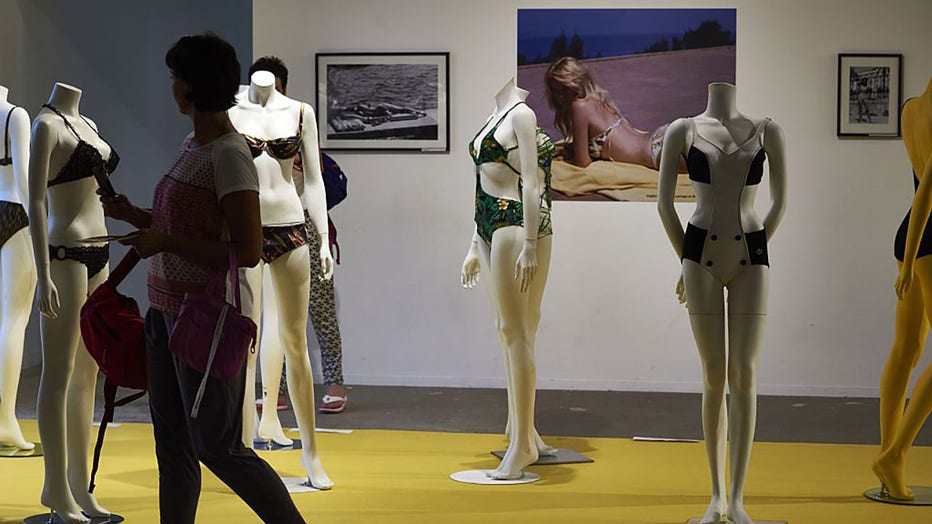National Bikini Day: History of the controversial two-piece suit

FILE - Michele Bernardini showing off on July 5, 1946, the first bikini, created by the fashion designer Louis REARD. (Photo by Keystone-France/Gamma-Keystone via Getty Images)
On July 5, 1946, French designer Louis Réard unveiled a scandalous two-piece swimsuit in Paris, which met pushback in the beginning, but ultimately became one of the most popular forms of swimwear.
Réard’s new suit debuted at the Piscine Molitor, a popular swimming pool in the French capital, with Parisian showgirl Micheline Bernardini modeling the new fashion, according to History.com.
Réard called the swimwear a "bikini," inspired by a news-making U.S. atomic test that took place off the Bikini Atoll in the Pacific Ocean earlier that same week, the History Channel site states.

FILE - U.S. Military Atomic Bomb Test and Resulting Explosion, Bikini Island, Pacific Ocean, 1946. (Photo by: Universal History Archive/Universal Images Group via Getty Images)
Prior to this, women in Europe had been wearing two-piece bathing suits since the 1930s, but it was a halter top and shorts with only a sliver of midriff, the site says.
"In the United States, the modest two-piece made its appearance during World War II, when wartime rationing of fabric saw the removal of the skirt panel and other superfluous material," the History Channel said. "Meanwhile, in Europe, fortified coastlines and Allied invasions curtailed beach life during the war, and swimsuit development, like everything else non-military, came to a standstill."
Bikini debuts during a liberated summer
Western Europeans celebrated their first war-free summer in 1946 after years of war, and designers sought to match that energy with fashion designs.
Two French designers, Jacques Heim and Louis Réard, developed competing prototypes of the bikini, according to History.com – with Heim calling his the "atom" and advertising it as "the world’s smallest bathing suit."
Réard's bikini was essentially a bra top and two inverted triangles of cloth connected by string and was "significantly smaller," the site says, made of just 30 inches of fabric. The designer promoted his creation as "smaller than the world’s smallest bathing suit."
But according to the History Channel, Réard had trouble finding a professional model who would wear his scandalous two-piece suit.
"So he turned to Micheline Bernardini, an exotic dancer at the Casino de Paris, who had no qualms about appearing nearly nude in public," the site reads.
"As an allusion to the headlines that he knew his swimsuit would generate, he printed newspaper type across the suit that Bernardini modeled on July 5 at the Piscine Molitor. The bikini was a hit, especially among men, and Bernardini received some 50,000 fan letters," it adds.

FILE - A woman visits the exhibition "70 years of the Bikini," on July 11, 2016, at La Sucrière in Lyon. (Photo credit: JEAN-PHILIPPE KSIAZEK/AFP via Getty Images)
Bikini makes a slash, and ultimately lands in America
Younger, bolder women started donning bikinis along the Mediterranean coast, causing some pushback and even measures passed in Spain and Italy banning such suits on public beaches.
However, changing times meant the bikini grew in popularity on European beaches by the 1950s, according to the History Channel.
"Réard's business soared, and in advertisements he kept the bikini mystique alive by declaring that a two-piece suit wasn’t a genuine bikini ‘unless it could be pulled through a wedding ring,’" the website states.
But in "prudish America," the bikini was resisted for several more years until the early 1960s, according to History.com. By then, a new emphasis on youthful liberation and other changing tides meant the suit went from controversial to mainstream, the site added.
Stars like Brigitte Bardot and Raquel Welch made bikinis fashionable, while pop singer Brian Hyland’s "Itsy Bitsy Teenie Weenie Yellow Polka-Dot Bikini" in 1960 also immortalized the suit. California surf culture celebrated by groups like the Beach Boys also helped the bikini’s popularity, according to the History Channel.
Over the decades, bikinis have further evolved, like string bikinis. By the 1990s, increasingly small bikini designs earned the nickname "microkini" – including Karl Lagerfeld’s creation for Chanel’s spring 1996 collection.
July 5 is now National Bikini Day, a time to celebrate and wear the now mainstream form of beachwear.
This story was reported from Cincinnati

